Start This Recipe at least 3 days before you want to eat it
Dinner Table Rating ![]()
![]()
![]()
![]()
![]()
![]()
1 thumb per family member
Cook’s Rating ![]()
![]()
![]()
Accessibility of ingredients, ease of preparation, and affordability
We’re not Jewish. But we read the story of Moses to our kiddos one day recently and they became enamored with the Passover. We told them that Jewish people still celebrate the Passover and they instantly wanted to have our own Passover celebration. So, we did. And we needed some “unleavened bread”. Which is how I came to be trying out my first recipe from Nourishing Traditions: Zarathustra Bread.
I spent some time with a long list of Google results to find out exactly where this bread originated and discovered that Zarathustra is the founder of Zoroastrianism. Zarathustra apparently led quite an ascetic life, sleeping on the ground and eating coarse, humble bread. I thought it was profoundly ironic to be using the recipe for our Passover celebration.
Here is the (short) list of ingredients for Sally Fallon’s Zarathustra Bread, all of which can be obtained at a good grocery store or natural food store:
- 3 cups soft wheat berries
- 1/4 cup sesame seeds or caraway seeds (optional)
- water
- 1 teaspoon sea salt
- 1/2 cup currants or raisins (optional)
Our local natural food store only had hard wheat berries, so that’s what I used. The higher gluten content of hard wheat berries makes for a denser bread. And if you’re making bread with no leavening, then it makes sense to use the soft wheat berries. So, if you want your bread to turn out as light as possible, definitely track down the soft wheat berries.
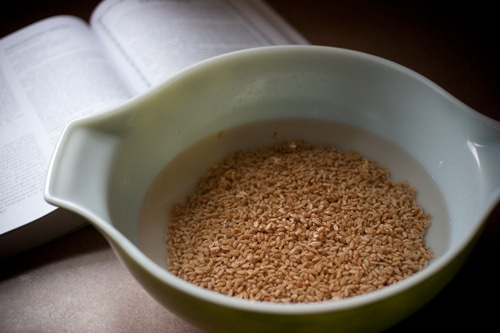
1. Place wheat berries and optional seeds (if using) in a bowl. Cover with water and leave in a warm, dark place for 24 hours.
One of the MO’s of the Nourishing Traditions book is soaking grains. There are naturally occurring elements in grains that interfere with digestion and absorption of minerals. By soaking, you neutralize these elements. So once you get around to consuming the grain, it has already been partially digested for you. I think it’s a pretty brilliant concept, myself.
After combining my wheat berries and water, I placed the bowl on top of our fridge, which is where I put anything that requires a warm, dry place. I also covered the bowl with a towel, because I am always a little freaked out by the story of the mouse in Anne’s pudding. Though if you, too, cover your bowl with a towel, don’t let the center dip into the water because you just might find a steady stream of water trickling down the side of your fridge–not that I’d know anything about that.
2. The next day, drain the water and replenish with clean water. Leave in a warm, dark place for another 24 hours.
3. On the third day, test the wheat berries to see if they are soft. If they are still hard when pinched, replace the water again and leave another 24 hours.
My wheat berries were ready after two days. But I didn’t need the bread until the next day, so I put them back for another 24 hours. They certainly weren’t harmed by the extra time. I think you can feel free to leave them soaking until you can get around to them (but before they start sprouting).
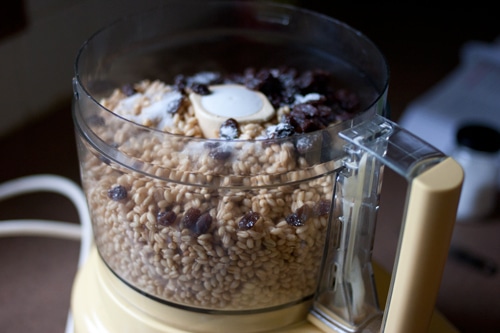
4. Once your wheat berries are soft, pour off the excess water. Transfer the berries with a slotted spoon (to leave behind as much water as possible) to a food processor. Add the sea salt and the optional currants or raisins. Process until smooth.
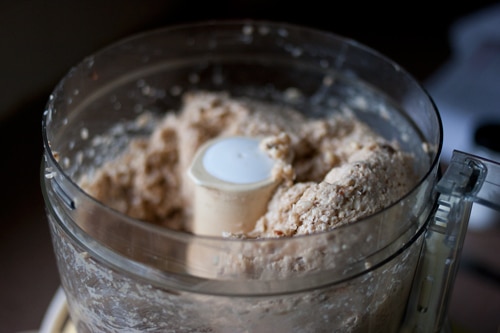
Sally’s instructions say to process the wheat berries first, then add the raisins, but I always find it better to process everything together. It seems to distribute more evenly that way. In my processor, it took about two minutes to get it the texture I wanted. In the end this is what it looked like:
I could have processed longer and made it smoother, but I liked the texture that the partially ground berries gave the dough. So I chose to stop at this point.
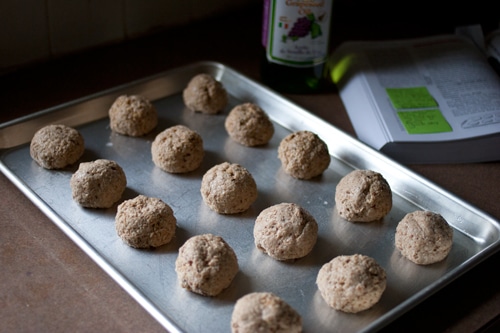
5. Form into balls and flatten slightly. Place on a stainless steel baking sheet brushed with oil or butter and bake about 12 hours in a 150 degree oven, turning after about six hours.
The recipe says it makes 10 loaves, but, as you see, I got 15. I made mine dinner roll-size, so maybe they ought to have been larger? I thought they worked well this way, too.
I greased my sheet with grapeseed oil, with some hesitation about the oil cooking onto the sheet. It worked fairly well, but I think next time I’ll use parchment paper. I also found that the lowest temperature on my oven is 170 degrees, so they cooked slightly faster.
The recipe says that if you live somewhere hot and dry you can bake these in the sun. I think that would be too much fun, and would love to try it that way sometime.
So, did they eat it?
Absolutely. Every person in my family loved this bread. Even the Peanut, who is in that phase of throwing everything on the floor and staring at it wonderingly. They loved it again the next morning when we served it with butter and jam. The Papa said it started tasting a little stale by dinner time though, which is to be expected from any home made bread.
With my diet restrictions, I couldn’t try it personally. But I imagined the flavor and texture to be similar to that of a Scottish oat cake. I’m sure I would have added my approval, had I been able to eat it.
Was it time consuming, expensive or difficult?
I suppose you could say it was time consuming, because it took three days from start to finish. But I literally had about 10 minutes total of hands-on time during that whole three days. So, no, I didn’t find it to be cost-, time-, or labor-prohibitive.
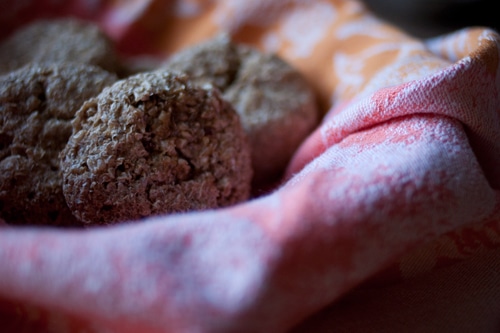
A pretty successful start, right out of the gate. Our hopes are high!
